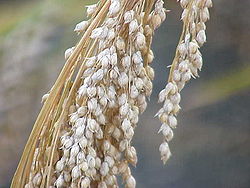Panicum
Genus of grasses From Wikipedia, the free encyclopedia
Panicum (panicgrass)[2] is a large genus of about 450 species of Poaceae grasses native throughout the tropical regions of the world, with a few species extending into the northern temperate zone. They are often large, annual or perennial grasses, growing to 1–3 m (3–10 ft) tall.[3][4]
| Panicum | |
|---|---|
 | |
| P. virgatum | |
| Scientific classification | |
| Kingdom: | Plantae |
| Clade: | Tracheophytes |
| Clade: | Angiosperms |
| Clade: | Monocots |
| Clade: | Commelinids |
| Order: | Poales |
| Family: | Poaceae |
| Subfamily: | Panicoideae |
| Supertribe: | Panicodae |
| Tribe: | Paniceae |
| Subtribe: | Panicinae |
| Genus: | Panicum L. |
| Synonyms[1] | |
| |
The flowers are produced in a well-developed panicle often up to 60 cm (24 in) in length with numerous seeds, which are 1–6 mm (0.04–0.24 in) long and 1–2 mm (0.04–0.08 in) broad. The fruits are developed from a two-flowered spikelet. Only the upper floret of each spikelet is fertile; the lower floret is sterile or staminate. Both glumes are present and well developed.[5][6][7][8][9][10]
Australia has 29 native and 9 introduced species of Panicum.[11][12][13]
Well-known species include P. miliaceum (proso millet) and P. virgatum (switchgrass).
Selected species
Summarize
Perspective
- Panicum abscissum Swallen (endemic to Florida)
- Panicum amarum Elliott – bitter panicum (North America)
- Panicum anceps Michx. – beaked panicum (United States)
- Panicum antidotale Retz. – blue panicum (South Asia, Himalayas)
- Panicum capillare L. – witchgrass, tumbleweed[14] (North America)
- Panicum coloratum L. – kleingrass, coolah grass, Bambatsi panic (Africa)
- Panicum decompositum R.Br. – native millet (Australia)
- Panicum dichotomiflorum Michx. – fall panicgrass (North America)
- Panicum effusum R.Br. – hairy panic (Australia, New Guinea)
- Panicum fauriei Hitchc. – Faurie's panicgrass (endemic to Hawai'i)
- Panicum flexile (Gattinger) Scribn. – wiry panicgrass (eastern North America)
- Panicum hallii Vasey – Hall's panicgrass (North America)
- Panicum havardii Vasey – Havard's panicgrass (North America)
- Panicum hemitomon Schult. – maidencane (Americas)
- Panicum hillmanii Chase – Hillmann's panicgrass (North America)
- Panicum hirticaule J.Presl – Mexican panicgrass (Americas)
- Panicum lycopodioides Bory ex Nees – false club-moss panic grass (Réunion)
- Panicum maximum Jacq. – Guinea grass, buffalo grass (Africa, Palestine, Yemen)
- Panicum miliaceum L. – proso millet, common millet (domesticated)
- Panicum niihauense H.St.John – lau 'ehu (endemic to Hawai'i)
- Panicum obtusum Kunth – vine mesquite grass (North America) (possible synonym of Hopia obtusa)
- Panicum pygmaeum R.Br. – Australian native dwarf panicum, rainforest panicum
- Panicum repens L. – torpedo grass (widely introduced)
- Panicum rigidum Balf.f. (endemic to Socotra)
- Panicum simile Domin – two colour panic (Australia)
- Panicum socotranum Cope (endemic to Socotra)
- Panicum sumatrense Roth – little millet (Asia)
- Panicum turgidum Forssk. – afezu (Africa, Asia)
- Panicum urvilleanum Kunth – desert panicgrass (North America)
- Panicum virgatum L. – switchgrass (North America)
Formerly classified in this genus, according to The Plant List:
- Acostia gracilis, formerly named Panicum acostia R.D.Webster
- Echinochloa colona – jungle rice, formerly named Panicum colonum L.
- Echinochloa crus-galli – barnyard grass, formerly named Panicum crus-galli L.
- Urochloa panicoides – annual signal grass, formerly named Panicum helopus Trin.
Gallery
- P. miliaceum (Proso)
- P. phragmitoides
- P. torridum
- P. xerophyllum
- P. trichoides
References
External links
Wikiwand - on
Seamless Wikipedia browsing. On steroids.










